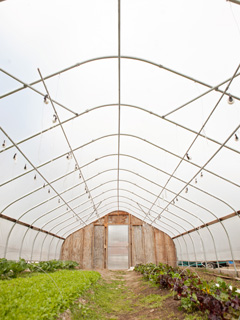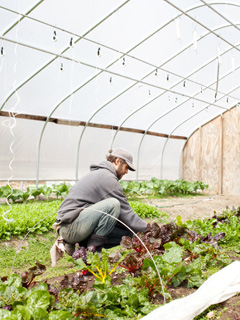 story by Liz Pacheco | photos by Emily WrenEntering the high tunnel at Mort Brooks Memorial Farm in Mount Airy is a little like stepping into a time machine. In early March, there are dense rows of rainbow chard and arugula, and a few beds have green stems poking through the soil. Farm manager Rick Rigutto reaches down and pulls out some chard, munching on a pink-hued stalk as he walks through the tunnel. While it’s been unseasonably warm, these greens shouldn’t be ready for eating for weeks. Most farms shut down by December, but Mort Brooks keeps on growing – and not in greenhouses. Instead they use sturdy, metal pipe frames covered in plastic sheeting known as high tunnels. The structure’s concept is based on greenhouse principles, but this is simpler – no electric, gas or water lines required. Sunlight streams through the plastic, warming the soil and providing an ideal winter oasis for hardy greens, which are planted directly in the ground. During warmer months, the sides are rolled up and the doors opened, creating a climate more suited to cut flowers and tomatoes. The tunnels are essentially season extenders, ensuring farmers and their crops year-round support and protection.
story by Liz Pacheco | photos by Emily WrenEntering the high tunnel at Mort Brooks Memorial Farm in Mount Airy is a little like stepping into a time machine. In early March, there are dense rows of rainbow chard and arugula, and a few beds have green stems poking through the soil. Farm manager Rick Rigutto reaches down and pulls out some chard, munching on a pink-hued stalk as he walks through the tunnel. While it’s been unseasonably warm, these greens shouldn’t be ready for eating for weeks. Most farms shut down by December, but Mort Brooks keeps on growing – and not in greenhouses. Instead they use sturdy, metal pipe frames covered in plastic sheeting known as high tunnels. The structure’s concept is based on greenhouse principles, but this is simpler – no electric, gas or water lines required. Sunlight streams through the plastic, warming the soil and providing an ideal winter oasis for hardy greens, which are planted directly in the ground. During warmer months, the sides are rolled up and the doors opened, creating a climate more suited to cut flowers and tomatoes. The tunnels are essentially season extenders, ensuring farmers and their crops year-round support and protection.
Thanks to Penn State Extension, high tunnels have made serious inroads at Philadelphia urban farms. What began as a project by a Penn State horticulture professor has blossomed into a new farming community. The High Tunnel Alliance is a group of 10 Philadelphia organizations with food-growing agendas – community groups like Weavers Way Co-op, public and private schools, recreation centers and even food banks. Through the alliance, these organizations have received funding and training to install and operate the tunnels. Just as importantly, the organizations have found a community and support group for the technology, something that’s never existed for urban farmers before in Philadelphia.
From rural classroom to city farms
Dr. William “Bill” Lamont, a horticulture professor at Penn State University, has been experimenting with high tunnels since 1998. He picked up the idea from a retired colleague at the University of New Hampshire. If the technology worked in New England, thought Lamont, then why not in the Mid-Atlantic?
Lamont applied for several Pennsylvania Department of Agriculture grants to build high tunnels at State College. “But I always felt that there were so many opportunities in the urban environments,” he says.
The first tunnel went up a few years ago at the Saul High School for Agriculture in Roxborough. But the results were mixed. “My short read of the situation is that it wasn’t really maintained well and it kind of became marginalized,” explains John Byrnes, director at Penn State Extension in Philadelphia, the educational outreach branch that connects communities with the University’s resources and expertise.
Traditionally, the University’s extension services have focused on rural areas and large-scale agricultural operations. So when the tunnel went up at Saul High School, the extension service was still trying to figure out how best to support the city’s growing urban farming movement. As Byrnes and his colleagues began building relationships with area farmers, Lamont expressed interest in expanding his high tunnels project. Soon, Byrnes was playing matchmaker, connecting Lamont with interested Philadelphia farms.
Lamont’s second Philadelphia tunnel went up at Mort Brooks just a couple of years ago. The farm, part of Awbury Arboretum and run by Weavers Way, was the first member in what has become the Penn State Extension High Tunnel Alliance. Since then, nine other members have been added, including Saul High School, whose tunnel was revived after collaborating with the Weavers Way Community Program Henry Got Crops!
Simple technology, more food
High tunnels are built to control variables. The plastic sheeting allows the sides to be easily rolled or unrolled for ventilation. Without rain exposure, water can be completely managed, typically with drip irrigation. And plant varieties can be selected for the specific tunnel conditions; crops like peppers, hardy greens and tomatoes have been successful.
“[The tunnel] basically allows us to grow crops late into the year and keep crops harvestable all winter,” explains Rigutto, “and obviously, allows us to get an early start on the season.”
Another benefit of the tunnels is their size. Most alliance members are working with limited space. “If you’re trying to grow as many vegetables as possible in a small space, a high tunnel can increase your yield by up to a third,” explains Bill Shick, farm manager at Nice Roots Farm, part of the SHARE food program and an alliance member. SHARE, which operates from an 180,000-square-foot warehouse in North Philadelphia, collects and grows food which is distributed to approximately 500 local food cupboards and soup kitchens, as well as sold through their discount grocery package program. They also sell to the general community.
“I have local tomatoes and peppers about a month earlier than the other growers because of the high tunnel,” says Shick. “So, if you’re one of the only people at market with a vegetable, you can get more money for it.” But being a nonprofit, the money isn’t as important, he insists. “We’d rather this produce be accessible to people.…We’re just trying to get more volume of food.”
And volume has definitely increased. With two tunnels and a farm, SHARE harvested 6,500 pounds of produce last year. More than half, about 3,500 pounds, was from the tunnels. Sweet peppers and tomatoes did especially well in 2011, says Shick, who has also found success with greens like spinach, lettuce, kale, collards and Swiss chard.
Learning from fellow farmers
Through the alliance, members receive important support and training, as well as the opportunity to communicate with local farmers doing the same work. “By having a group of [farmers who have] tunnels coordinating with one another, you’re able to create a rubric of performance and problems and issues,” explains Jerome Shabazz, the agriculture entrepreneur educator for Penn State Extension in Philadelphia and one of the original alliance developers. “[It’s] a network that will allow you to have a greater success of crop production.”
“We share information on pest problems we are seeing,” says Shick. “Some may see them a week or two before they become problems in others and it is good to have a heads up.” Shick also mentions sharing planting schedules, construction techniques for building tunnels, and even early seedlings he grows for alliance members who would have trouble finding them at garden supply centers so early in the season.
“If everyone is keeping track of what they’re doing and how they’re doing it,” says Rigutto, “you have nine other minds…contributing to a knowledge pool you can pull from and learn different techniques.”
 Extending the season and the community
Extending the season and the community
While maximizing production is an important part of Lamont’s research, he sees high tunnels as serving critical community and education purposes as well. At Mort Brooks, the tunnel has become part of the curriculum, teaching kids the difference between high tunnels and greenhouses. At Saul, the high school students run a Community Supported Agriculture program, while some produce goes directly to their cafeteria; the tunnels have allowed them to work an extended season and increase yields. And at SHARE, the steady stream of volunteers isn’t interrupted by the weather – there’s always work to do in the tunnels.
Most of the alliance members are large organizations, but Penn State Extension has heard from smaller entities as well. A waiting list has formed and there are plans to expand the alliance with additional funding.
“This is the kind of thing that I can’t wait to put in front of my dean because, basically, extension in Pennsylvania is still pretty rural, big agriculture mindset,” says Byrnes. “And we’re just constantly on a mission to make sure that the fine work that’s going on down here with the Bill Shicks and everybody else is getting the resources and attention they deserve.”



He picked up the idea from a retired colleague at the University of New Hampshire. If the technology worked in New England, thought Lamont, then why not in the Mid-Atlantic?
He picked up the idea from a retired colleague at the University of New Hampshire. If the technology worked in New England, thought Lamont, then why not in the Mid-Atlantic?
As the farmers produce good food crops we can get good food products to eat. to stay healthy all the time we always need good products of food to eat. We also have to do more exercises to stay fit. As the growth of farmers and farms arises it will be more beneficial for the human kinds. .
As the farmers produce good food crops we can get good food products to eat. to stay healthy all the time we always need good products of food to eat. We also have to do more exercises to stay fit. As the growth of farmers and farms arises it will be more beneficial for the human kinds. .